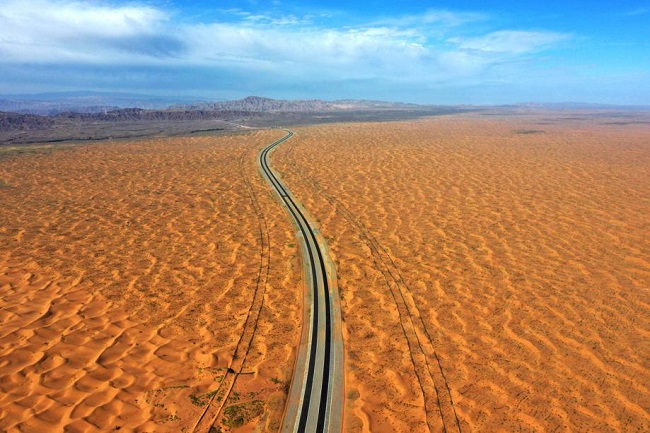
The expressway crosses the Tengger Desert in the Ningxia Hui autonomous region. [Photo by Guo Tao/For chinadaily.com.cn]
The first cross-desert expressway in Northwest China's Ningxia Hui autonomous region is expected to open by the end of this year, a year ahead of schedule, according to the regional transport commission.
The 122.9-kilometer Qingtongxia-Zhongwei section of the Wuhai-Maqen highway, built at a cost of 7.94 billion yuan ($1.23 billion), will run across the Tengger Desert in Ningxia.
Construction of the section, with a designed top speed of 100 kilometers per hour, started in 2019.
A six-layer system to prevent sand erosion has been installed along the expressway, and a variety of sand-resistant plants have been planted along it to build a green and low-carbon "ecological corridor".
To boost the integrated development of transport and tourism, two service areas have been set up along the section passing through the desert to allow drivers and their passengers to stop and enjoy the views.
When the section opens to traffic, it will improve the highway network of the city of Zhongwei, boost regional transport development, and promote economic and social development.
Feng Jianjun, head of Zhongwei's transport commission, told Ningxia Daily that the next step is to build more service areas with different themes, such as tourism and adventure.
Elements such as oases, camping and campfires will attract tourists and boost the high-quality development of tourism and transportation, he said.
The Wuhai-Maqen expressway, which will run across the Inner Mongolia autonomous region, Ningxia, and the provinces of Gansu and Qinghai, will link less-developed areas in North and Northwest China with the rest of the country.
The new expressway will extend China's freeway network, which now spans 160,000 km, ranking first in the world.
China opened its first expressway, connecting Shanghai and the satellite town of Jiading, in 1988, when developed countries, such as the United States and Germany, already had expressway networks in place.
Though late to the game, China has caught up quickly, with the development of the expressway network reflecting China's accomplishments in infrastructure construction.
Another high-profile desert-crossing expressway, the G7 that links Beijing with the Xinjiang Uygur autonomous region, opened in July. Crossing more than 500 km of uninhabited desert, it spans more desert than any other expressway in the world.
According to a national transport plan, by 2035, China will have built a freeway network that allows residents of most county-level regions to reach an expressway in half an hour.